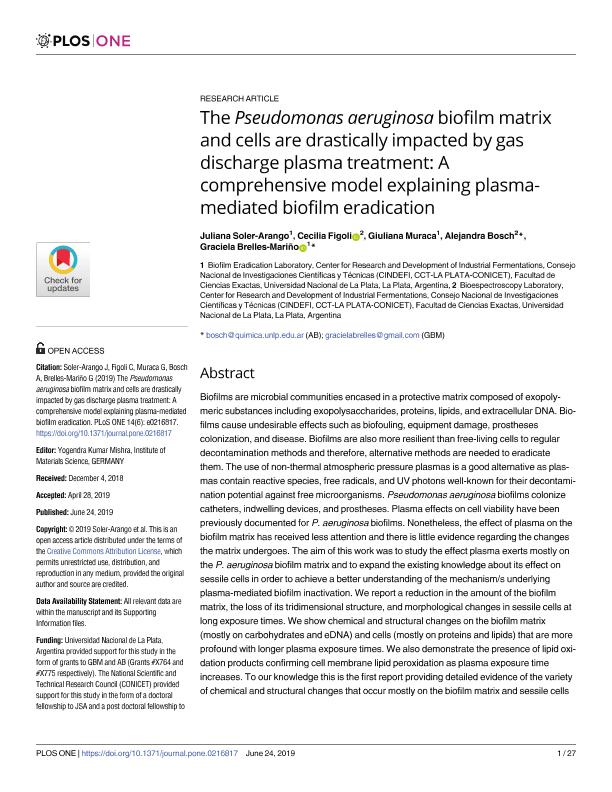Artículo
The Pseudomonas aeruginosa biofilm matrix and cells are drastically impacted by gas discharge plasma treatment: A comprehensive model explaining plasma-mediated biofilm eradication
Soler Arango, Juliana ; Fígoli, Cecilia Beatríz
; Fígoli, Cecilia Beatríz ; Muraca, Giuliana Sabrina; Bosch, María Alejandra; Brelles Mariño, Graciela
; Muraca, Giuliana Sabrina; Bosch, María Alejandra; Brelles Mariño, Graciela
 ; Fígoli, Cecilia Beatríz
; Fígoli, Cecilia Beatríz ; Muraca, Giuliana Sabrina; Bosch, María Alejandra; Brelles Mariño, Graciela
; Muraca, Giuliana Sabrina; Bosch, María Alejandra; Brelles Mariño, Graciela
Fecha de publicación:
06/2019
Editorial:
Public Library of Science
Revista:
Plos One
ISSN:
1932-6203
Idioma:
Inglés
Tipo de recurso:
Artículo publicado
Clasificación temática:
Resumen
Biofilms are microbial communities encased in a protective matrix composed of exopolymeric substances including exopolysaccharides, proteins, lipids, and extracellular DNA. Biofilms cause undesirable effects such as biofouling, equipment damage, prostheses colonization, and disease. Biofilms are also more resilient than free-living cells to regular decontamination methods and therefore, alternative methods are needed to eradicate them. The use of non-thermal atmospheric pressure plasmas is a good alternative as plasmas contain reactive species, free radicals, and UV photons well-known for their decontamination potential against free microorganisms. Pseudomonas aeruginosa biofilms colonize catheters, indwelling devices, and prostheses. Plasma effects on cell viability have been previously documented for P. aeruginosa biofilms. Nonetheless, the effect of plasma on the biofilm matrix has received less attention and there is little evidence regarding the changes the matrix undergoes. The aim of this work was to study the effect plasma exerts mostly on the P. aeruginosa biofilm matrix and to expand the existing knowledge about its effect on sessile cells in order to achieve a better understanding of the mechanism/s underlying plasma-mediated biofilm inactivation. We report a reduction in the amount of the biofilm matrix, the loss of its tridimensional structure, and morphological changes in sessile cells at long exposure times. We show chemical and structural changes on the biofilm matrix (mostly on carbohydrates and eDNA) and cells (mostly on proteins and lipids) that are more profound with longer plasma exposure times. We also demonstrate the presence of lipid oxidation products confirming cell membrane lipid peroxidation as plasma exposure time increases. To our knowledge this is the first report providing detailed evidence of the variety of chemical and structural changes that occur mostly on the biofilm matrix and sessile cells as a consequence of the plasma treatment. Based on our results, we propose a comprehensive model explaining plasma-mediated biofilm inactivation.
Archivos asociados
Licencia
Identificadores
Colecciones
Articulos(CINDEFI)
Articulos de CENT.DE INV EN FERMENTACIONES INDUSTRIALES (I)
Articulos de CENT.DE INV EN FERMENTACIONES INDUSTRIALES (I)
Articulos(SEDE CENTRAL)
Articulos de SEDE CENTRAL
Articulos de SEDE CENTRAL
Citación
Soler Arango, Juliana; Fígoli, Cecilia Beatríz; Muraca, Giuliana Sabrina; Bosch, María Alejandra; Brelles Mariño, Graciela; The Pseudomonas aeruginosa biofilm matrix and cells are drastically impacted by gas discharge plasma treatment: A comprehensive model explaining plasma-mediated biofilm eradication; Public Library of Science; Plos One; 14; 6; 6-2019; 1-27
Compartir
Altmétricas



